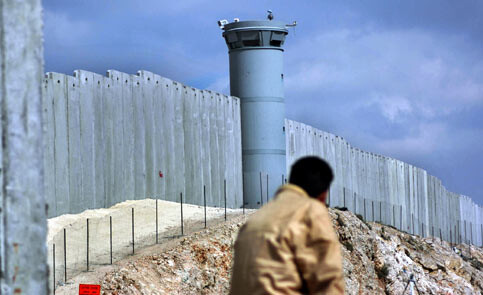Humanitarian Emergency Policy GroupLocal Aid Coordination Committee 28 March 2006

A general view of the construction site of the Israeli separation wall in Qalandiya between Ramallah and Jerusalem March 18, 2006. (MaanImages/Moamar Awad)
In June 2004 the Ministry of Planning (MoP) presented its “Guidelines for Wall Mitigation” (1) to the LACC (2). These Cabinet-approved guidelines are aimed at the donor community and include a number of mitigation measures in response to the construction of the Barrier. The recommended measures include: ensuring the integrity and capacity of the local community to maintain social, economic, infrastructure and development contacts and links; supporting Palestinian Authority (PA) strategic objectives; assisting the efforts of Palestinians to remain in their homes and on their lands, and facilitating the movement of Palestinians across the Barrier structures from either side. It prioritises such mitigation measures for areas located in the “Seam Zone” (the area between the Barrier and the 1949 Armistice Line, the “Green Line”) and those affected by the Barrier in the Jerusalem area.
Meanwhile, on 9th July the International Court of Justice (ICJ) issued an Advisory Opinion on the “Legal Consequences of the Construction of a Wall in the Occupied Palestinian Territory.” The ICJ found that the Barrier, in its present route and projection, and with the set of rules and regulations that govern its construction and operation, constituted a severe violation of International Human Rights and Humanitarian Law. The ICJ recognised three operative legal obligations for donors operating in the occupied Palestinian territory (oPt):
1) not to recognise the illegal situation resulting from the construction of the Barrier,
2) not to render aid or assistance towards maintaining the situation created by such construction, and
3) to take action to end the impediments to Palestinian self-determination resulting from the construction of the Barrier and to ensure Israel�s compliance with the Fourth Geneva Convention.
In trying to determine whether or not to undertake a wall mitigation3 project, the PA is considering whether to adopt a traffic light system, whereby “Red Light” projects are clearly inconsistent with the ICJ Opinion, “Green Light” projects are clearly consistent with the ICJ Opinion, and “Orange Light” projects require a case-by-case review.
Perspectives within the international donor community on how to approach wall mitigation and address the implications of the ICJ Opinion are far from consistent. Some donors are strongly in favour of wall mitigation on humanitarian grounds, while others express serious concern regarding undertaking any form of wall mitigation initiative on political or legal grounds. Many donors, meanwhile, have not formulated a clear position.
During interviews with donors (4) currently undertaking wall mitigation projects, three recurring issues emerged. The perceived contradiction between humanitarian obligations versus political concerns; the need for a common LACC position on how to approach wall mitigation in an effective and consistent manner, and which is legally consistent with the ICJ Opinion; and the need for the donor community to consider how to ensure compliance by the Government of Israel (GoI) with its obligations under International Humanitarian Law (IHL).
In conclusion, this paper outlines four suggested recommendations:
1. It should be ensured that the GoI complies with its obligations under IHL. This should be done at (a) the local level and, (b) at the capital level.
2. The MoP should establish a “Clearing House”, dedicated to evaluating wall mitigation projects. Those that are officially approved should be given MoP approval declaring them suitable for funding.
3. LACC Recommendations could be defined that would clarify and determine how donors could address the legal and practical implications of undertaking wall mitigation projects.
4. Donors who do not channel proposals through the MoP should include a Project Impact Assessment into their project cycle in order to evaluate whether or not the project would contradict the ICJ Opinion or the MoP Guidelines.
To download the full report (PDF) click here.
Footnotes
[1] The PA plans to integrate these guidelines in its Medium-Term Development Plan, which will be published shortly. The legal implications of the International Court of Justice (ICJ) Opinion will also be outlined in the Medium-Term Development Plan.
[2] Formal LACC meeting held on 24th June 2004 in Ramallah.
[3] It should be noted that the phrase “wall mitigation” is used to describe activities that aim to alleviate the effects of the Barrier on Barrier-affected communities. The international community recognises and uses the terms, “Separation Barrier” and “Wall”. Within the context of this report the physical construction is consistently referred to as the Barrier.
[4] Interviews were conducted between 1st September and 31st October 2004.
Related Links